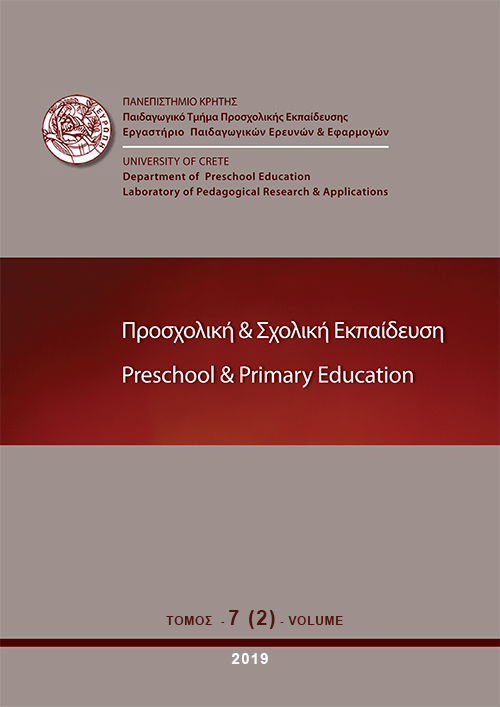Interactive Shared Book Reading with a Narrative and an Informational Book: The effect of genre on parent-child reading
Περίληψη
Introduction: Previous studies indicate the dominance of narrative fiction in shared book reading. Theory and research suggests this may contribute to reading difficulties.
Purpose of the Study: This study contrasted the impact of two genres on shared book reading based on factors known to maximize children’s literacy development. It also examined the participants’ perspectives regarding their interactive reading behaviors.
Methods: Eight parent-child dyads, with children four- and five-years-old, read a non-narrative informational book and a narrative fictional book. The study controlled for the books’ reading levels, Rockets and Spaceships (Guided Reading K, Lexile 520) and A Penguin Pup for Pinkerton (Guided Reading K, Lexile 510).
Results: Analysis showed that informational book features such as captions, predictable text, and a glossary supported interactive reading behaviors. Children engaged more with concrete, factual concepts, and answered and asked more questions with the informational book.
Implications and Conclusions: Analysis showed that the non-narrative informational text encouraged more children's interactive reading behaviors known to develop emergent literacy skills. The informational text was more engaging for children because of 1) book features/characteristics, and 2) the information presented. Parents were generally unaware of the benefits of reading multiple genres to their children.Λεπτομέρειες άρθρου
- Πώς να δημιουργήσετε Αναφορές
-
Baldwin, C. G., & Morrow, L. M. (2019). Interactive Shared Book Reading with a Narrative and an Informational Book: The effect of genre on parent-child reading. Preschool and Primary Education, 7(2), 81–101. https://doi.org/10.12681/ppej.20909
- Τεύχος
- Τόμ. 7 Αρ. 2 (2019)
- Ενότητα
- Άρθρα

Αυτή η εργασία είναι αδειοδοτημένη υπό το CC Αναφορά Δημιουργού – Μη Εμπορική Χρήση – Παρόμοια Διανομή 4.0.
Οι συγγραφείς των άρθρων που δημοσιεύονται στο ΠΡΟΣΧΟΛΙΚΗ & ΣΧΟΛΙΚΗ ΕΚΠΑΙΔΕΥΣΗ διατηρούν τα δικαιώματα πνευματικής ιδιοκτησίας επί των άρθρων τους, δίνοντας στο περιοδικό το δικαίωμα της πρώτης δημοσίευσης. Άρθρα που δημοσιεύονται στο ΠΡΟΣΧΟΛΙΚΗ & ΣΧΟΛΙΚΗ ΕΚΠΑΙΔΕΥΣΗ διατίθενται με άδεια Creative Commons 3.0 και σύμφωνα με την άδεια μπορούν να χρησιμοποιούνται ελεύθερα, με αναφορά στο/στη συγγραφέα και στην πρώτη δημοσίευση για μη κερδοσκοπικούς σκοπούς και με δικαίωμα τροποποίησης μόνον με παρόμοια διανομή (αν αναμείξετε, τροποποιήσετε, ή δημιουργήσετε πάνω στο υλικό, πρέπει να διανείμετε τις δικές σας συνεισφορές υπό την ίδια άδεια όπως και το πρωτότυπο). To Εργαστήριο Παιδαγωγικών Ερευνών και Εφαρμογών του Παιδαγωγικού Τμήματος Προσχολικής Εκπαίδευσης του Πανεπιστημίου Κρήτης και το Εθνικό Κέντρο Τεκμηρίωσης διατηρούν το δικαίωμα να δημοσιεύουν, να αναπαραγάγουν, να παρουσιάζουν στο κοινό, να διανέμουν και χρησιμοποιούν άρθρα που δημοσιεύονται στο ΠΡΟΣΧΟΛΙΚΗ & ΣΧΟΛΙΚΗ ΕΚΠΑΙΔΕΥΣΗ σε οποιοδήποτε μέσο και μορφή είτε μεμονωμένα είτε ως μέρη συλλογικών έργων, για όλο το χρόνο διάρκειας προστασίας της πνευματικής ιδιοκτησίας και για όλες τις χώρες του κόσμου. Αυτό περιλαμβάνει ενδεικτικά και όχι αποκλειστικά, το δικαίωμα δημοσίευσης των άρθρων σε τεύχη του περιοδικού ΠΡΟΣΧΟΛΙΚΗ & ΣΧΟΛΙΚΗ ΕΚΠΑΙΔΕΥΣΗ, αναπαραγωγής και διανομής μεμονωμένων αντιγράφων των άρθρων, αναπαραγωγής ολόκληρων των άρθρων σε άλλη έκδοση του Εργαστηρίου Παιδαγωγικών Ερευνών και Εφαρμογών του Παιδαγωγικού Τμήματος Προσχολικής Εκπαίδευσης του Πανεπιστημίου Κρήτης και του Εθνικού Κέντρου Τεκμηρίωσης και αναπαραγωγής και διανομής των άρθρων ή περίληψης αυτών με χρήση πληροφορικού συστήματος αποθετηρίου.



